[ April 12 - May 12, 2002 ]
It has long been our desire to travel to and collect beetles in the very south of Iran, in the Persian Gulf region and this year our dreams came true. From an extensive literature search it followed that the best time to visit this region would be April as most adults of the local species occur at this time. An especially challenging task for us appeared to be a longhorn beetle whose name we just loved as soon as we first heard it:
"JEBUSAEA HAMMERSCHMIDTI"
This exotic beetle, associated with the True Date Palm also used to be known as Bagdadatocerambyx, a name which we loved even more as it sounded very peculiar.Our group met in the International Airport Istanbul. The weather in Turkey was cold and wet in the first half of April. All the snow covered mountain peaks and leafless trees in the valleys of eastern Anatolia did not promise much fun at all (Figure 1). Therefore, we drove straight to the Iranian border almost without any breaks.
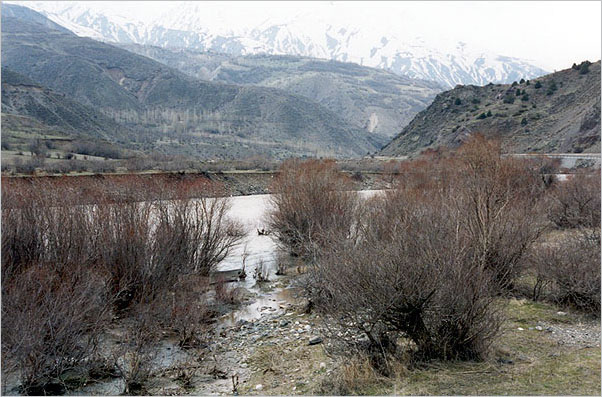
Figure 1 [Photo © M.Rejzek] E Turkey, surroundings of Erzinzan, 13.IV.2002 |
Entering Iran this year was a pleasant surprise. The central customs building on the Iranian side of the border in Bazargan has recently been completely reconstructed providing travellers with very decent facilities and very helpful English speaking staff. Also the weather started to improve slightly while we were descending to the somewhat lower altitudes of northern Iran. However, cold windy periods were alternated by rain and occasional hail on a daily basis.
Our first stop and camping site was planned for our favourite locality near the village of Serou in NW Iran. The actual site is mountainous meadows with hardly any higher vegetation. The locality proved to be an unusually rich source of new taxa. In comparison to the neighbouring countryside these meadows are not heavily grazed but mowed to produce hay for winter stock feeding.
In the roots of Centaurea imperialis we collected larvae of Phytoecia (Helladia) imperialis (Sama et Rejzek), a species recently described from this locality. Moreover, we found roots of Centaurea behen attacked by larvae of another species, Phytoecia (Semiangusta) rebeccae (Sama et Rejzek), currently being described from this locality. Phytoecia (Cardoria) scutellata (Fabricius) was another representative of the tribe Phytoeciini collected here. Dorcadion (Cribridorcadion) scabricolle Dalman and Dorcadion (Cribridorcadion) hellmanni Ganglbauer occurred quite abundantly too. However, by far the most interesting longhorn beetle collected here was a new, very nice species of Dorcadion related to Dorcadion (Cribridorcadion) piochardi Kraatz, a species known from NW Turkey.
On our way to the south, down the Zagros Mountains, we made a number of short stops (Nagade, Saqqez, Divandarre, Horramabad, and Askaran) in mainly higher altitudes and concentrated ourselves on searching for Dorcadion. Dorcadion (Cribridorcadion) hellmanni and Dorcadion (Cribridorcadion) scabricolle were the most frequently recorded species. In addition we also found Dorcadion (Cribridorcadion) laeve Faldermann and Dorcadion (Cribridorcadion) cingulatum Ganglbauer, a species endemic to Iran. The most interesting animal recorded here was a still undetermined Dorcadion species. Apart from Mallosia (Eusemnosia) mirabilis (Faldermann) and Phytoecia (Cardoria) scutellata there were hardly any other adult Cerambycidae. On our return, Osphranteria coerulescens inaurata Holzschuh hatched from larvae we collected in dead branches of an Amygdalus species.

Figure 2 [Photo © M.Rejzek] W Iran, province Lorestan, pass 52 km E Horramabad, 18.IV.2002 |
We headed south down the Zagros Mountains to their southern extreme and stopped to collect there in the surroundings of the city of Siraaz (Figure 3). In a mountainous steppe formation we discovered perhaps the most spectacular Dorcadion species ever, the legendary Dorcadion (Cribridorcadion) brunneicolle Kraatz. We found out that the species is associated with a still undetermined herbaceous plant. Another surprising discovery was the finding of a still undetermined, and perhaps new Coptosia species, which resembles to some extent Coptosia (Pseudocoptosia) elyandti (Semenov). Moreover, from larvae found in Acer monspessulanum we reared a still undetermined Purpuricenus species. Phytoecia (Musaria) puncticollis puncticollis Faldermann, Agapanthia (Agapanthoplia) coeruleipennis Frivaldszky, Phytoecia (Phytoecia) virgula (Charpentier), and Dorcadion (Cribridorcadion) hellmanni represented the less spectacular species recorded here.

Figure 3 [Photo © M.Rejzek] S Iran, province Fars, surroundings of Siraaz, 20.IV.2002: a mountainous steppe formation |
In a really beautiful place called Dast-e Arzan in the same region (Figures 4 and 5) we collected a really rare species, Xenopachys matthiesseni (Reitter). On our return, Chlorophorus adelii Holzschuh hatched from larvae collected in the dead wood of oak.
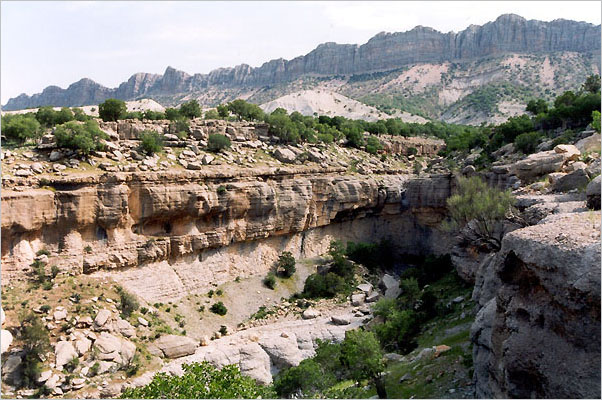

Figures 4 and 5 [Photo © M.Rejzek] S Iran, province Fars, Dast-e Arzan W Siraaz, 22.IV.2002: a locality of Xenopachys matthiesseni |
Eventually we left the mountainous regions and started our descent to the lowlands surrounding the Persian Gulf. The lower we went, the higher climbed the temperature indicated by our thermometer. Starting from a comfortable 15 °C we ended up with 48 °C and really high humidity on top of it. The early spring of the mountain region suddenly turned into an unbearable tropical hell. In a number of different localities around the city of Bandar-e ‘Abbās (Genu, Angohran, Minab, Hasan Langi, and Faryab) we collected only one Cerambycidae species during the day: Osphranteria lata Pic. The countryside in this area was, however, really spectacular (Figures 6 to 15).



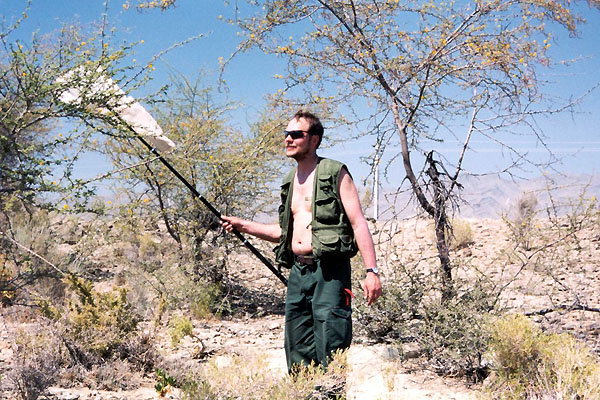
Figures 6 - 9 [Photo © M.Rejzek] S Iran, province Hormozgan, Angohran, 24.IV.2002 A river bed covered with saxaul (Figure 6) and "intrepid explorers" 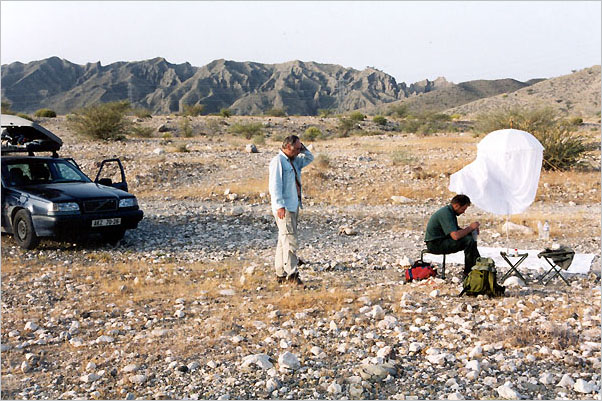
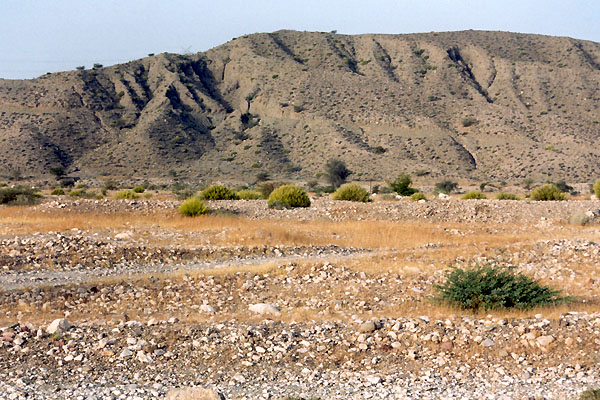
Figures 10 and 11 [Photo © M.Rejzek] S Iran, province Hormozgan, Faryab, 27.IV.2002 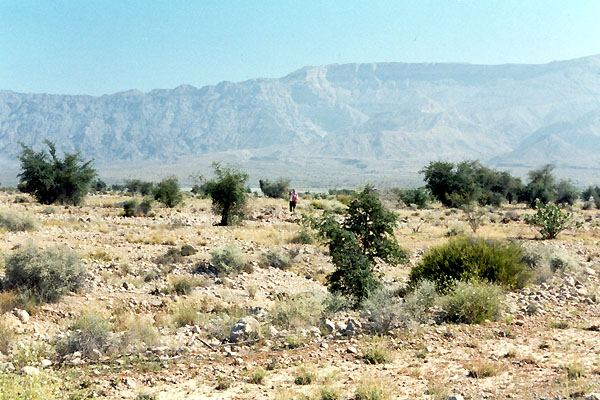
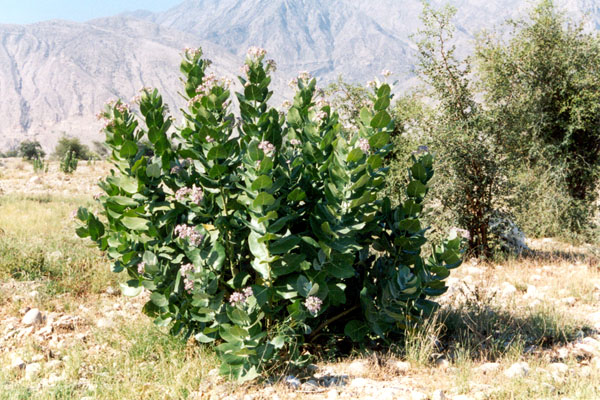
Figures 12 and 13 [Photo © M.Rejzek] S Iran, prov. Hormozgan, Genu, 23.IV.2002 An arid habitat with Acacia sp. and Prunus sp. (Figure 12) Calotropis procera, host plant of Niphona indica Breuning, 1938 (Figure 13) 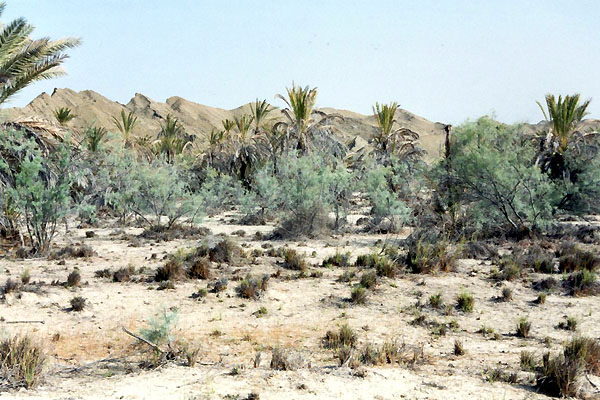

Figures 14 and 15 [Photo © M.Rejzek] S Iran, province Hormozgan, Minab, 29.IV.2002 True Date Palm (Phoenix dactilifera) the host of Jebusaea hammerschmidti Reiche, 1877 |
Very soon we gave up any attempts to do any collecting during the day and did not leave an air conditioned hotel room before dusk. Attracting beetles to light and collecting at night using a torch proved to be the most sucessful methods for this region (Figures 16 to 19). Among the species that were attracted to our light trap were Iranobrium davatchii Villiers, Derolus iranensis Pic, Diorthus (Diorthus) cinereus (Fabricius), Idactus iranicus Breuning (also collected on its still undetermined host), and the desired Jebusaea hammerschmidti Reiche. The greatest surprise however came on our return home; Stanislav Kadlec sitting in his smoky study determined a strange looking longhorn beetle which we attracted to light as Zoodes compressus (Fabricius). In addition, Niphona (Niphona) indica Breuning was collected on its host (Figure 13) at night. This species never came to the light trap.
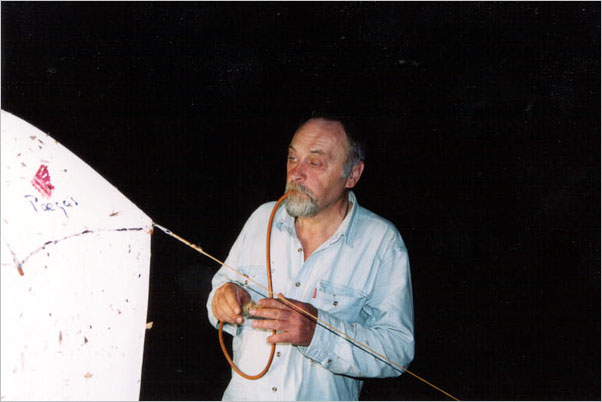
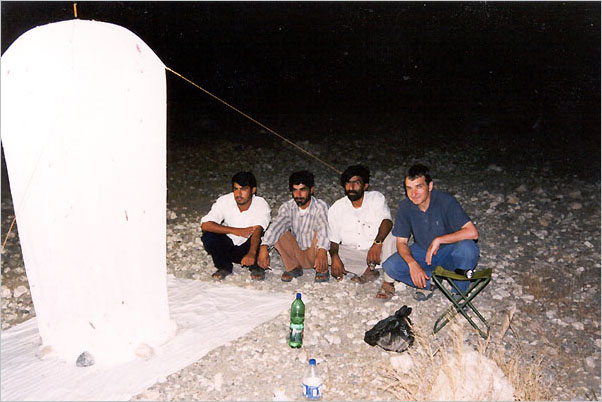
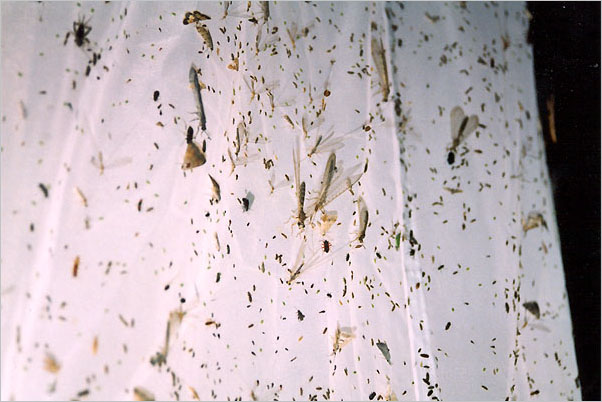
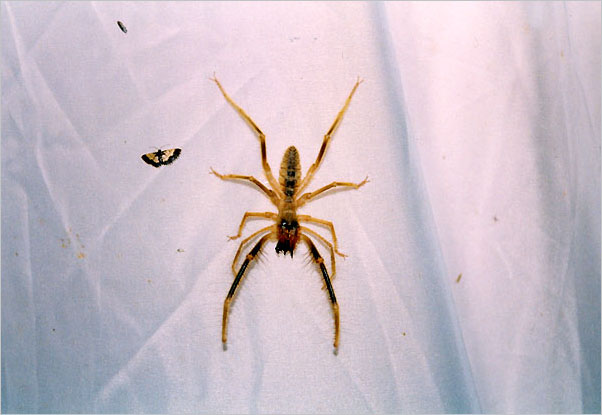
Figures 16 - 19 [Photo © M.Rejzek] S Iran, province Hormozgan, surroundings of Bandar-e Abbas, 23.-29.IV.2002: light collecting |
On our way back home we briefly searched the north of Iran (Tagarak, Aveg, Yele Qarsu, Helabad, Nir, Bostanabad, Sefide Khan, and Marand) and besides several species mentioned already, we collected Cortodera pseudomophlus Reitter, Xylotrechus arvicola (Olivier), Phytoecia (Helladia) pretiosa Faldermann, Phytoecia (Helladia) humeralis (Waltl), Phytoecia (Helladia) testaceovittata (Pic), Phytoecia (Pilemia) annulata Hampe, Phytoecia (Pilemia) hirsutula (Frölich), Dorcadion (Cribridorcadion) danczenkoi Danilevsky, Dorcadion (Cribridorcadion) semiargentatum sarabense Holzschuh, and Dorcadion (Cribridorcadion) semiargentatum semiargentatum Pic. Moreover, we collected larvae of Paracorymbia tonsa (K. et J. Daniel) and reared adults on our return. The journey back to Istanbul was uneventful with one short stop in eastern Anatolia yielding Dorcadion (Cribridorcadion) wagneri Küster and a Dorcadion species related to Dorcadion cinerarium (Fabricius). And finally the "Good bye!" happened in Istanbul. My friends went home to Prague and I went back to Norwich to serve the Queen.
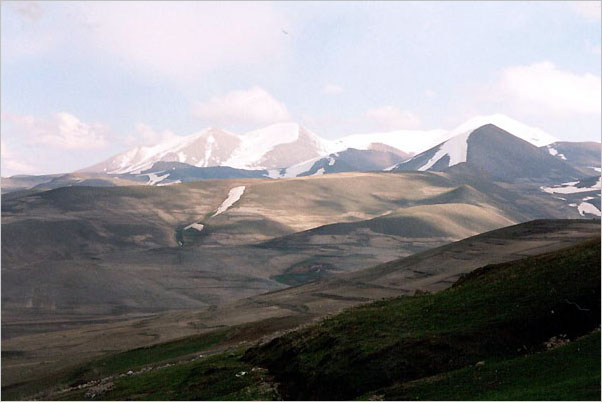
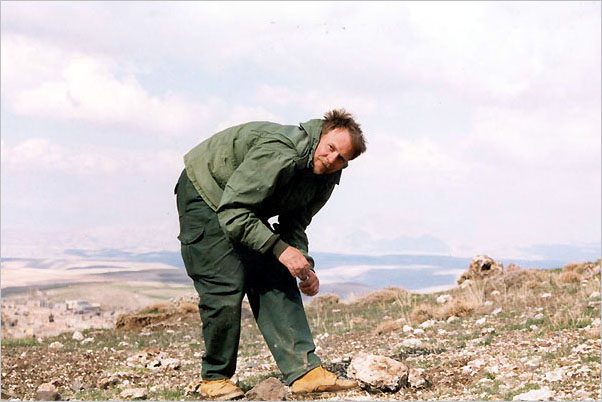
Figures 20 - 21 [Photo © M.Rejzek] N Iran, province Āzarbāijān-e Sharqi, Sefide Khan 25 km S Tabriz, 7.V.2002 Volcano Kūh-e Sahand, 3707 m (Figure 20) ...and one of expedition members busy collecting Dorcadion (Figure 21) |
Last but not least, we would like to thank all the unknown Persian people who we met on our journey and who were extremely helpful and kind to us. We hope that they manage to preserve their very decent and polite attitude to strangers even when tourists start streaming into their amazingly beautiful and spectacular country. Thank you!
